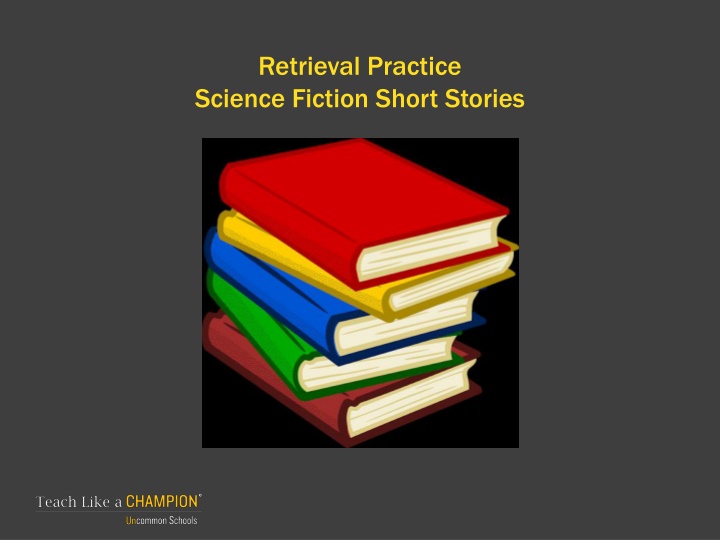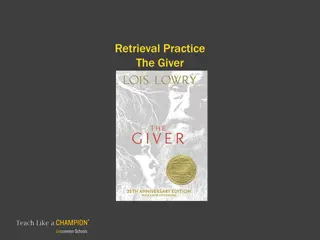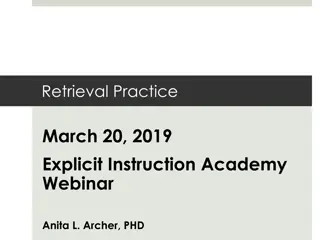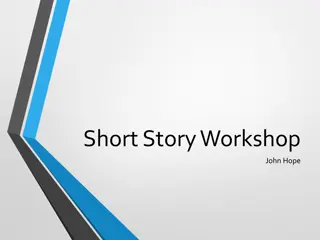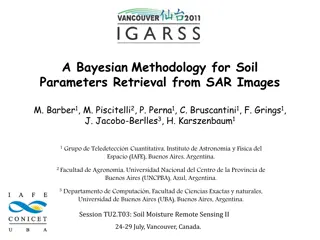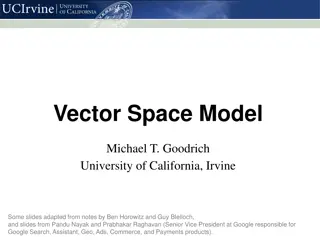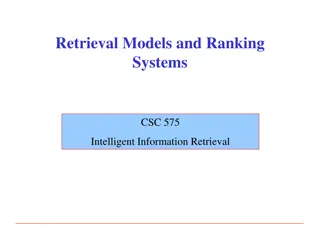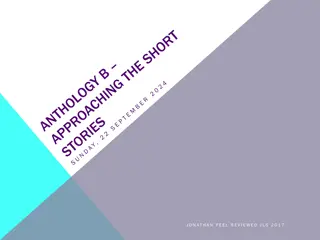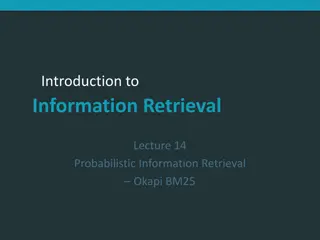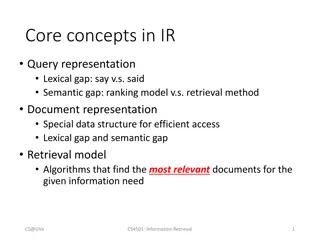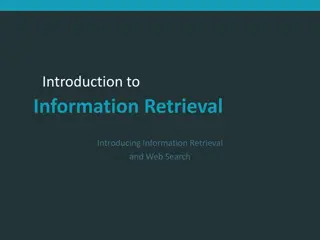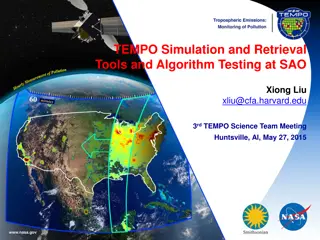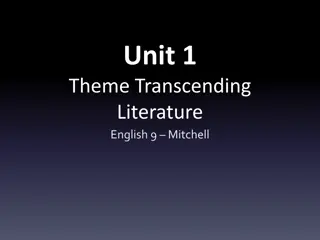Science Fiction Retrieval Practice: Short Stories Insights
Explore futuristic technologies, incongruity, and speculative fiction elements in science fiction short stories like "Robbie" and "There Will Come Soft Rains." Uncover the connections to historical events, like the Cold War, through literary analysis of these captivating narratives.
Download Presentation

Please find below an Image/Link to download the presentation.
The content on the website is provided AS IS for your information and personal use only. It may not be sold, licensed, or shared on other websites without obtaining consent from the author.If you encounter any issues during the download, it is possible that the publisher has removed the file from their server.
You are allowed to download the files provided on this website for personal or commercial use, subject to the condition that they are used lawfully. All files are the property of their respective owners.
The content on the website is provided AS IS for your information and personal use only. It may not be sold, licensed, or shared on other websites without obtaining consent from the author.
E N D
Presentation Transcript
Retrieval Practice Science Fiction Short Stories
Retrieval Practice: Lesson 3 (Robbie) 1. Name one futuristic technology futuristic technology in Robbie. 2. What does it mean for something to be incongruous incongruous? 3. What term describes fiction in which the laws of the world are different than ours? 4. In what year was Robbie first published? Challenge: What was the story s original name? 5. Explain the irony irony of Asimov s description of 1998. 6. What happened to the Talking Robot? Why? Take 3 minutes to complete these questions
Retrieval Practice Answers: Lesson 3 (Robbie) 1. Futuristic technologies in Robbie include flying cars, robot nurses, and any other elements that do not exist in real life but might occur in the future. 2. Incongruity refers to the state of being out of place, inconsistent, or incompatible. 3. The term speculative fiction describes fiction in which the laws of the world (either explicit or implied) are different than ours. 4. The story Robbie was published in 1940. Challenge Strange Playfellow. Challenge: The original title was 5. Ironically, the future Asimov imagined for the year 1998 is radically different from what was actually the case. 6. The Talking Robot was unable to process the fact that there were other robots and burned out its circuits. Self-score: ________/6
Retrieval Practice: Lesson 6 (There Will Come Soft Rains) 1. What term describes fiction concerning the destruction of the human race? 2. Name one example of a futuristic technology in There Will Come Soft Rains. 3. What happened at Hiroshima and Nagasaki in 1945? 4. In There Will Come Soft Rains, what allusion is there to the events at Hiroshima and Nagasaki? 5. How did the relationship between the United States and the Soviet Union change after World War II? Take 3 minutes to complete these questions 6. What is anthropomorphism?
Retrieval Practice Answers: Lesson 6 (There Will Come Soft Rains) 1. The term post-apocalyptic refers to fiction set after an apocalypse or devastating event causing decline of humanity or Earth itself. 2. One futuristic technology in There Will Come Soft Rains is the fully automatic house. 3. In 1945, the United States detonated nuclear weapons over the Japanese cities of Hiroshima and Nagasaki. 4. In There Will Come Soft Rains, the destruction of the city and the nuclear shadows left by the family are allusions to the nuclear destruction of Hiroshima and Nagasaki. 5. After World War II, the relationship between the United States and the Soviet Union became increasingly tense and escalated into the Cold War. 6. Anthropomorphism refers to a type of personification that gives human characteristics to non-humans. Self-score: ________/6
Retrieval Practice: Lesson 9 (Flowers for Algernon) 1. What term describes the period of conflict between the United States and the Soviet Union after World War II? 2. What was the nuclear arms race? 3. What is world-building in science fiction? 4. Why might Mary Shelley s Frankenstein be considered one of the first true works of science fiction? 5. Is the story There Will Come Soft Rains post-apocalyptic? What about the poem? Explain your thinking. Take 3 minutes to complete these questions
Retrieval Practice Answers: Lesson 9 (Flowers for Algernon ) 1. The Cold War was a period of conflict between the United States and the Soviet Union after World War II. 2. The nuclear arms race was a time during which the United States and the Soviet Union spent billions of dollars to build stockpiles of nuclear weapons. 3. World-building refers to an author s creation of an imagined or speculative reality. 4. Mary Shelley s Frankenstein tells of the impact of an imagined science on the world and individuals. 5. Both would be considered post-apocalyptic because they are set after an apocalypse or devastating event causing the decline of humanity or Earth itself. Self-score: ______ /5
Retrieval Practice: Lesson 14 (Harrison Bergeron) 1. What is a motif? Give one example from this unit. 2. What is a parallel episode? 3. Explain the significance of allusion in Flowers for Algernon. 4. What is irony? Describe one ironic moment in Flowers for Algernon. 5. Why was the conflict between the United States and the Soviet Union called the Cold War? Challenge: Who gave the conflict this name? 6. Define social commentary. Take 3 minutes to complete these questions
Retrieval Practice Answers: Lesson 14 (Harrison Bergeron ) 1. A motif is a meaningful pattern; an image, idea, or symbol that repeats throughout a text. One example is <insert example here>. 2. A parallel episode is a scene or chapter in which things that happened earlier happen again in a different context. 3. In Flowers for Algernon, Keyes uses allusions to demonstrate Charlie s progress and to connect to major themes. 4. Irony refers to moments in which in which what appears to be true differs radically from what is actually the case. One example is <insert example here>. 5. The Cold War is so named because it never escalated into open war between the two powers. Challenge Challenge: The term was first used by author George Orwell. 6. A social commentary is a piece of art used to comment on or critique issues in society. Self-score: ______ /6
Retrieval Practice: Lesson 16 (Harrison Bergeron) 1. What is an absurdity? Give one example of an absurdity from Harrison Bergeron. 2. What is an allusion? Name one text alluded to in Flowers for Algernon. 3. What happened at Hiroshima and Nagasaki? What role did this event play in the Cold War? 4. What allusions to Hiroshima and Nagasaki have we seen in this unit? 5. Which term better describes Harrison Bergeron, dystopian or post-apocalyptic? Why? 6. Define irony and provide an example from a story we ve read in this unit. 7. What year was Harrison Bergeron first published? How long after the end of World War II was this? Take 3 minutes to complete these questions 8. Challenge: What was Vonnegut s role in World War II?
Retrieval Practice Answers: Lesson 16 (Harrison Bergeron) 1. An absurdity is something completely unreasonable, purposeless, extremely silly, or ridiculous . One example is <insert example here>. 2. An allusion is a reference to a person, place, thing or idea of historical, cultural, literary or political significance. In Flowers for Algernon, Keyes alludes to the Book of Genesis and Paradise Lost. 3. The detonation of nuclear weapons over Hiroshima and Nagasaki led to the nuclear arms race during the Cold War. 4. Bradbury alludes to Hiroshima and Nagasaki in the story There Will Come Soft Rains. 5. Harrison Bergeron is a dystopian story because it depicts an imagined society in which there is great suffering or injustice. 6. Irony refers to situations in which what appears to be true differs radically from what is actually the case. One example is <insert example here>.
Retrieval Practice Answers: Lesson 16 (Harrison Bergeron) Cont d 7. Harrison Bergeron was published in 1961, 16 years after the end of World War II. 8. 8. Challenge Challenge: During World War II, Kurt Vonnegut was German prisoner of war during the firebombing of Dresden. Self-score: ______ /8
Retrieval Practice: Lesson 19 (The Ones Who Walk Away from Omelas) 1. What does it mean for a statement to be a paradox? 2. What is the terrible paradox of life in Omelas? 3. What term describes an ideal society or an imagined place in which everything is perfect? Challenge: Explain the origin of this term. 4. Explain 1-2 characteristics of a satire. 5. Could a story be both dystopian and post-apocalyptic? Explain. 6. In what year was The Ones Who Walk Away from Omelas first published? Take 3 minutes to complete these questions
Retrieval Practice: Lesson 19 (The Ones Who Walk Away from Omelas) 1. A paradox is a statement that is seemingly contradictory or opposed to common sense and yet is perhaps true. 2. The terrible paradox of life in Omelas is that the perfect happiness of the people of Omelas depends on the misery of one child. 3. The term utopia describes an ideal society or imagined place in which everything is perfect. Challenge Challenge: This word was coined by Sir Thomas More by combining the Greek words for no and place. 4. A satire uses of humor, irony, sarcasm, incongruity, or absurdity to criticize or ridicule people or institutions. 5. Yes; a story could be both post-apocalyptic (set after an apocalypse or other devastating event) and dystopian (about an imagined society in which there is great suffering or injustice). 6. The Ones Who Walk Away from Omelas was published in 1971. Self-score: ______ /6
Retrieval Practice: Lesson 22 (The Great Silence) 1. What term refers to an author s choice to leave an event or idea open to multiple interpretations? 2. What is the difference between a utopia and a dystopia? 3. Define the term paradox. 4. What does it mean for a piece of fiction to be speculative? 5. Which stories in this unit were written by Ray Bradbury? 6. Who invented the word robotics ? 7. What is anthropomorphism? Take 3 minutes to complete these questions
Retrieval Practice Answers: Lesson 22 (The Great Silence) 1. Ambiguity refers to an author s choice to leave an event or idea open to multiple interpretations. 2. A utopia is an imagined society where everything is perfect; a dystopia is an imagined society in which there is great suffering or injustice. 3. A paradox is a statement that is seemingly contradictory or opposed to common sense and yet is perhaps true. 4. Speculative fiction describes a world in which the laws (either explicit or implied) are different from ours. 5. There Will ComeSoft Rains and All Summer in a Day were written by Ray Bradbury. 6. Isaac Asimov invented the word robotics. 7. Anthropomorphism refers to a type of personification that gives human characteristics to non-humans. Self-score: ______ /7
